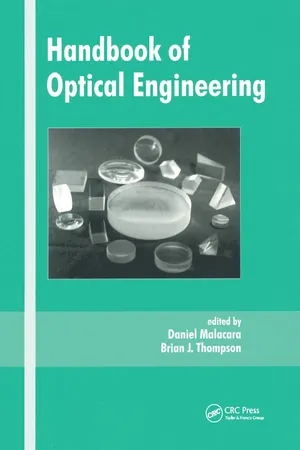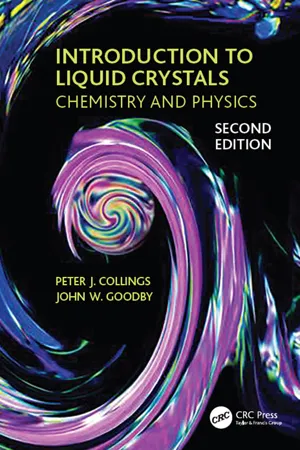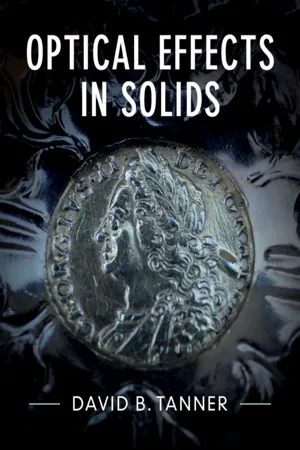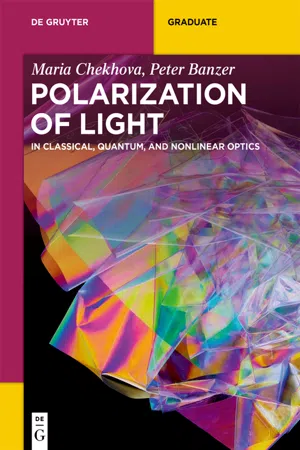Physics
Anisotropy
Anisotropy refers to the property of a material exhibiting different physical characteristics when measured in different directions. In physics, anisotropy can manifest in various forms, such as electrical, thermal, or magnetic anisotropy, and is commonly observed in crystals, liquid crystals, and some composite materials. This directional dependence plays a crucial role in understanding the behavior and properties of these materials.
Written by Perlego with AI-assistance
Related key terms
1 of 5
6 Key excerpts on "Anisotropy"
- eBook - PDF
- Daniel Malacara(Author)
- 2001(Publication Date)
- CRC Press(Publisher)
24 Anisotropic Materials DENNIS H. GOLDSTEIN Air Force Research Laboratory, Eglin AFB, Florida 24.1 INTRODUCTION In this chapter, we discuss the interaction of light with anisotropic materials. An anisotropic material has properties (thermal, mechanical, electrical, optical, etc.) that are different in different directions. Most materials are anisotropic. This Anisotropy results from the structure of the material, and our knowledge of the nature of that structure can help us to understand the optical properties. The interaction of light with matter is a process that is dependent upon the geometrical relationships of the light and matter. By its very nature, light is asym- metrical. Considering light as a wave, it is a transverse oscillation in which the oscillating quantity, the electric field vector, is oriented in a particular direction in space perpendicular to the propagation direction. Light which crosses the boundary between two materials, isotropic or not, at any angle other than normal to the boundary, will produce an anisotropic result. The Fresnel equations illustrate this. Once light has crossed a boundary separating materials, it experiences the bulk properties of the material through which it is currently traversing, and we are con- cerned with the effects of those bulk properties on the light. The study of Anisotropy in materials is important to understanding the results of the interaction of light with matter. For example, the principle of operation of many solid state and liquid crystal spatial light modulators is based on polarization modulation [5]. Modulation is accomplished by altering the refractive index of the modulator material, usually with an electric or magnetic field. Crystalline materials are an especially important class of modulator materials because of their use in electro-optics and in ruggedized or space-worthy systems, and also because of the potential for putting optical systems on integrated circuit chips. - eBook - ePub
Introduction to Liquid Crystals
Chemistry and Physics, Second Edition
- Peter J. Collings, John W. Goodby(Authors)
- 2019(Publication Date)
- CRC Press(Publisher)
3Nature’s Anisotropic Fluids — It’s All about Direction
3.1 Anisotropy
Solids either can be isotropic or anisotropic, depending on the molecules occupying lattice sites and the crystal lattice itself. For example, solids with cubic symmetry are isotropic, whereas solids with all the other possible symmetries are anisotropic. This Anisotropy manifests itself in the elastic, electric, magnetic, and optical properties of a material, in that measurements of an elastic modulus, dielectric constant, magnetic susceptibility, or index of refraction give different results depending on the direction along which they are measured.Because liquid crystals are fluids, they also show Anisotropy in their flow behavior, like logs flowing down a river. This can easily be understood by imagining measuring the viscosity of a liquid crystal by placing it between two flat plates and measuring the force necessary to move one plate past the other at a certain velocity. In Figure 3.1 , the plates lie in the x-y plane and are separated by a distance d. The bottom plate is fixed and the force acting on the top plate is in the x-direction, Fx. The velocity of the top plate is also in the x-direction, vx.Figure 3.1 shows three situations in which the director of the liquid crystal points along different directions. It is not difficult to imagine that the force necessary to move the top plate at a specified velocity is different for each situation. If two assumptions are made, namely that the flow is laminar and that the velocity of the fluid next to each plate moves with the same velocity as the plate, then the general definition of viscosity η as the shearing stress divided by the velocity gradient becomesFigure 3.1 Measuring the three viscosities of a nematic liquid crystal: (a) η1 , (b) η2 , and (c) η3 .η ==F xAdv xd z,F xdAv x(3.1) where A is the cross-sectional area of the plates. The resulting three viscosities, sometimes called the Miesowicz coefficients, are called η1 (director perpendicular to the flow and parallel to the velocity gradient), η2 (director parallel to the flow), and η3 (director perpendicular to the flow and perpendicular to the velocity gradient). A typical temperature dependence of the viscosities is given in Figure 3.2 , where it is clear that η1 - eBook - PDF
- David B. Tanner(Author)
- 2019(Publication Date)
- Cambridge University Press(Publisher)
15 Anisotropic Crystals 15.1 Optics of Crystals The study of anisotropic materials, the subject of this chapter, is often called “crystal optics,” because many crystalline solids exhibit anisotropic properties. In fact, only one of the seven systems known to crystallography, the cubic crystal system, has isotropic optical properties. I’ll define an anisotropic material as one having properties that depend on direction. “Direction of what?” is a fair question when faced with the definition I just gave. The answer: it is essentially always the direction of the electric field which controls wave propagation, charge transport, and optical absorption. Despite the large numbers of anisotropic crystals, anisotropic materials are not widely experienced in everyday life. Many persons have seen or used “polaroid,” plastic polarizing films [341]. These polarizing films are used as sunglasses and in photography; these devices are not single crystals but they are anisotropic. Polaroid sheet contains linear chains of absorbing molecules in a transparent polymer host. It absorbs light with linear polarization parallel to the chains and has maximum transmission for light with polarization rotated by 90 ◦ . Research life differs from everyday life. Many of the solids that have attracted the most attention in condensed-matter physics over the past several decades are anisotropic. The list includes cuprate superconductors, Fe-based superconductors, certain topological insulators, organic linear-chain conductors, electroactive polymers, graphene, graphite, carbon nanotubes, and others. - eBook - ePub
- B. D. Cullity, C. D. Graham(Authors)
- 2011(Publication Date)
- Wiley-IEEE Press(Publisher)
CHAPTER 7 MAGNETIC Anisotropy 7.1 INTRODUCTIONThe remainder of this book will be devoted, almost without exception, to the strongly magnetic substances, namely, ferro- and ferrimagnetics. Chapters 7–12 deal mainly with structure-sensitive properties, those which depend on the prior history (thermal, mechanical, etc.) of the specimen. In these chapters we shall be concerned chiefly with the shape of the magnetization curve; that is, with the way in which the magnetization changes from zero to the saturation value M s . The value of M s itself will be regarded simply as a constant of the material. If we understand the several factors that affect the shape of the M, H curve, we will then understand why some materials are magnetically soft and others magnetically hard.One factor which may strongly affect the shape of the M, H (or B, H ) curve, or the shape of the hysteresis loop, is magnetic Anisotropy. This term simply means that the magnetic properties depend on the direction in which they are measured. It is pronounced ann-eye- SOT-rope-ee . This general subject is of considerable practical interest, because Anisotropy is exploited in the design of most magnetic materials of commercial importance. A thorough knowledge of Anisotropy is thus important for an understanding of these materials.There are several kinds of Anisotropy:1. Crystal Anisotropy , formally called magnetocrystalline Anisotropy .2. Shape Anisotropy .3. Stress Anisotropy (Section 8.5).4. Anisotropy induced by a. Magnetic annealing (Chapter 10). b. Plastic deformation (Chapter 10). c. Irradiation (Chapter 10).5. Exchange Anisotropy (Section 11.8).Of these, only crystal Anisotropy is intrinsic to the material. Strictly, then, all the others are extrinsic or “induced.” However, it is customary to limit the term “induced” to the aniso- tropies listed under item 4 above. All the anisotropies from 1 to 5 (except 4c) are important in practice, and any one may become predominant in special circumstances. In this chapter we will consider only crystal and shape Anisotropy. - eBook - ePub
Polarization of Light
In Classical, Quantum, and Nonlinear Optics
- Maria Chekhova, Peter Banzer(Authors)
- 2021(Publication Date)
- De Gruyter(Publisher)
4 Optics of crystals: basic conceptsIn this chapter, we will consider the Anisotropy of optical materials, leading to birefringence and many other polarization effects that are discussed further in this book. We will restrict the discussion to linear optics, leaving the nonlinear effects to Chapter 10 . In addition, here we will consider light at a fixed wavelength and therefore avoid the consideration of optical dispersion. We will also ignore magnetic phenomena, by assuming the matter to be non-magnetic.4.1 Anisotropy of linear optical properties
As we will see, the linear optical properties of a material, in the general case, depend on the direction in which light propagates and, most importantly, on the polarization of light. This behavior is called Anisotropy and its various aspects will be discussed in this subsection.4.1.1 Dielectric tensor
We start with the Maxwell equations, assuming that the medium contains no charges and no currents. In this case, the general equations (2.7 ) simplify to (we omit the space and time arguments for brevity)(4.1)=∇ →×E →−,B →˙(4.2)=∇ →×H →,D →˙(4.3)=∇ →·D →0 ,(4.4)=∇ →·B →0 .In a non-magnetic material, the magnetic induction is simply proportional to the magnetic field,. The relation between the displacement and the electric field is less trivial: Eq. (2.8 ) readsB →=μ 0H →, whereD →=ϵ 0E →+P →P →is the polarization of the matter. The relation between the polarization and the electric field is provided by the first material equation of Eqs. (2.10 ); then(4.5)D →=ϵ 0ϵE →,whereϵ = 1 + χis the dielectric permittivity, also known as the dielectric function, and χ is the linear susceptibility. We have ignored the nonlinear dependence of polarizationP →on the electric fieldE →. We will take it into account in Chapter 10 , dedicated to nonlinear polarization optics.Consider now the Anisotropy contained in Eq. (4.5 ). It sets the relation between two vectors, the electric field and the displacement, through ϵ, which is therefore a tensor,ϵ. In the matrix form, Eq. (4.5i j - eBook - PDF
New Advanced High Strength Steels
Optimizing Properties
- Mohamed Goune, Thierry Iung, Jean-Hubert Schmitt(Authors)
- 2023(Publication Date)
- Wiley-ISTE(Publisher)
New Advanced High Strength Steels, coordinated by Mohamed GOUNÉ, Thierry IUNG, Jean-Hubert SCHMITT. © ISTE Ltd 2023. 2 Anisotropy and Mechanical Properties Hélène RÉGLÉ 1 and Brigitte BACROIX 2 1 Product Research Center, ArcelorMittal Research SA, Maizières-lès-Metz, France 2 LSPM, CNRS, Sorbonne Paris Nord University, Villetaneuse, France This chapter deals with the Anisotropy of mechanical properties, that is, the fact that they are dependent on the direction of loading. This means, for example, that different values of strength or elongation can be measured in an anisotropic sheet depending on whether it is loaded in tension in a direction parallel to the rolling direction (RD) or at 90° to it. Anisotropy can be a desired quality when the forming modes are themselves anisotropic, as in the case of deep drawing with swaging, where it is desired to limit the thinning of the sheet while deep drawing it. For ductile alloys, the Anisotropy depends mainly on the crystallographic textures. A polycrystalline material is said to have a texture when its grains are preferentially oriented in one or more identical orientations. Thus, a sheet whose grains are randomly oriented is said to be “isotropic”, while a sheet whose statistically large number of grains has, for example, a direction parallel to the RD (a fiber-type texture α) may have anisotropic properties. Some mechanical properties are indeed sensitive to the crystallographic direction of stress. For example, for an iron single crystal loaded in tension along the <100> direction, we will find a Young’s modulus of about 120 GPa, and about 280 GPa if loading takes place along the <111> direction. It is then understandable that, for a polycrystal, the presence of a texture, that is, a large number of identically oriented grains, can induce a global Anisotropy of the mechanical properties. 44 New Advanced High Strength Steels This chapter is structured in three parts.
Index pages curate the most relevant extracts from our library of academic textbooks. They’ve been created using an in-house natural language model (NLM), each adding context and meaning to key research topics.





